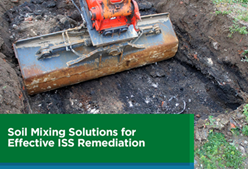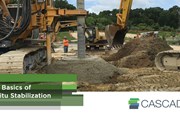Digging Deeper into In Situ Stabilization
By: Paul Lear, Ph.DIn situ stabilization (ISS) is a technology originally associated with the geotechnical stabilization of loose soils, and it can also function as a remediation treatment. When considering ISS for their remediation projects, clients often have many questions. This blog post will address some of the most common questions we hear, covering considerations to help you determine if ISS is the right solution for your project.
What Are Reasonable Depths For ISS? What Is The Deepest You’d Consider Using ISS For?
In Situ Stabilization (ISS) is typically performed at depths of 100 feet or less, though deeper treatment is possible depending on site conditions. The maximum achievable depth is highly influenced by lithology and denser materials like gravels, clays, and cemented layers require more force to penetrate and mix, which can limit depth.
The equipment used plays a key role in determining feasible depths. Bucket mixing or excavator-mounted tools are effective for depths up to 30 feet. Auger mixing with drill rigs can reach 100 feet or more, depending on torque capacity and site conditions. In some cases, benching or shallow pre-excavation allows for deeper treatment, such as up to 40 feet with a larger excavator or around 110 feet with an auger rig, considering groundwater levels.
When mixing at depth, there's a trade-off between efficiency and cost. Larger diameter augers increase daily production and reduce unit treatment costs but apply less force per unit area, making deeper penetration more challenging in dense materials. Smaller diameter augers generate more force, making them better suited for deeper mixing but at the expense of slower production and higher treatment costs per volume.
What Are The Effects Of ISS On Adjacent Structures?
When performing ISS near structures, careful planning is essential to minimize potential impacts. The three primary concerns are:
- Direct contact with structural elements
- Vibration-related damage, especially to older or fragile structures
- Differential settlement during or after ISS
To avoid physical interference, we review structural drawings or conduct test pitting as needed before starting work. As a general rule, we offset at least 1 foot from foundations and 2-3 feet from footers to prevent direct impact.
Seismic meters are used around the work zone to monitor vibration levels, ensuring they remain below thresholds that could damage nearby structures.
Settlement plates, strain gauges, and tilt-meters help assess ground movement during ISS. To reduce settlement risks, real-time compliance sampling is performed daily, evaluating bearing capacity and compressive strength to ensure stability.
To further mitigate risks, ISS is implemented in a primary-secondary-tertiary sequence:
- Primary cells/columns are treated first and allowed to cure for 3-7 days, followed by Unconfined Compressive Strength (UCS) testing to confirm sufficient strength (typically 35-50 psi UCS).
- Secondary and tertiary cells/columns follow the same process, ensuring incremental treatment along structural edges.
This method minimizes vibrations and differential settlement, ensuring adjacent structures remain stable throughout the ISS process.
If Mixing With Portland Cement, How Long Do The Cementitious Agents Remain Competent In Place In The Subsurface?
Based on literature such as the Performance Assessment of Solidified/Stabilised
Waste-forms, An Examination of the Long-term Stability of Cement-treated Soil and Waste (2010), there’s an expectation of complete containment for over 40 years and perhaps upwards of 100 years, depending on groundwater geochemistry. Change in geotechnical conditions of the subsurface groundwater system or physical altercation of the matrix itself may reduce that timeframe.
Are There Any Challenges To Working Near Tidal Rivers?
The major challenge is minimizing the flow velocity of the water during and immediately after treatment to prevent scouring and resuspension of the treated sediment before it has a chance to undergo settling. The “green” set of ISS-treated sediment typically occurs in the first 7-24 hours after treatment, so quiescent conditions should be maintained around ISS-treated sediment for that period. After the green set, the ISS-treated sediment should not be prone to scouring and resuspension by tidal flow.
The salinity of the water is something to keep in mind when using surface water or a groundwater source for reagent mixing or slurry production. The impact is in the mixed water, not necessarily in the groundwater.
A bench study is recommended for evaluating reagents when the site is in a brackish or saline environment adjacent to a saltwater body. That way, we can determine if we need a type 1 or type 2 Portland cement or something that’s going to be more appropriate for a high chloride content. This is also true of sodium bentonite, as it tends to collapse rather than swell when mixed with saltwater.
Is In Situ Stabilization Of Acid Tar Possible?
Yes, but it depends. Acid tars were mostly produced where sulfuric acid was utilized during the cracking process for oils and coal tars. The acid tars can retain a significant (>10% by volume) sulfuric acid. As part of the ISS treatment, the acidity of the acid tars needs to be neutralized using alkaline materials such as limestone, hydrated lime, quicklime, lime kiln dust, etc. This neutralization step often generates heat and steam from the latent heat of neutralization, may cause the release of odors, and is very detrimental to equipment materials of construction (e.g., seals, metal surfaces, pins, etc). The neutralized material is often chunky or powdery particulate. The neutralized acid tar would then be solidified with Portland cement or Portland cement/slag grout to produce a monolithic ISS-treated product.
Because of the exothermic neutralization step, the use of ISS for acid tars needs to be evaluated to determine if it is compatible with the goals for the material and the site, the material.
Do Regulators Find An ISS Approach Acceptable?
Yes, ISS is successfully implemented all over the world. You should check with your local regulatory agency to confirm its use for your specific project site.
Are There Any Methods To Stabilize Particular Depth Intervals?
Absolutely. We can tweak your injection fluid at a specific depth range to selectively treat a specific zone. It’s very easy to do with the equipment available today. As an example, this may be done in the Coal Combustion Residuals (CCR) world to treat beneath an impoundment.
We can adjust amendment ratios on nearly a per-foot basis by changing our fluid-to-reagent ratios or even our overall dosing in discrete zones. We like to plan for those intervals in advance and optimize treatment from a cost and performance standpoint. That way, the lowest passing criteria comply with the project goals.
What Is The Current Understanding Of Long-Term Effectiveness For ISS?
Based on literature such as the Performance Assessment of Solidified/Stabilised Waste-forms, An Examination of the Long-term Stability of Cement-treated Soil and Waste (2010), there’s an expectation that the solidified matrix will provide complete containment of contaminants for over 40 years and perhaps upwards of 100 years, depending on groundwater geochemistry. The contaminants, both metals and organics have been chemically immobilized and incorporated into the low permeability, high strength matrix.
If you have an upcoming project and think ISS might be a good fit, let us know.
About the Author

Paul Lear, Ph.D.
Senior Technical Director
Dr. Paul Lear, a leading authority in stabilization/solidification (S/S) technology, brings over 30 years of experience in full-scale remediation projects to Cascade. As a key technical expert in In Situ Stabilization (ISS), Dr. Lear has pioneered numerous groundbreaking advancements in the field.
His impressive career includes pioneering the first applications of in situ chemical oxidation and thermal treatment using auger mixers, establishing the first Construction and Maintenance Use Area (CAMU) for waste treatment in California, implementing the first full-scale S/S treatment for dioxin and explosive-contaminated soils, and groundbreaking ISS work at a manufactured gas plant site in New Jersey. Dr. Lear's expertise extends internationally, with notable achievements such as the first S/S of organic wastes in Australia and the first large-scale S/S treatment in Canada.



